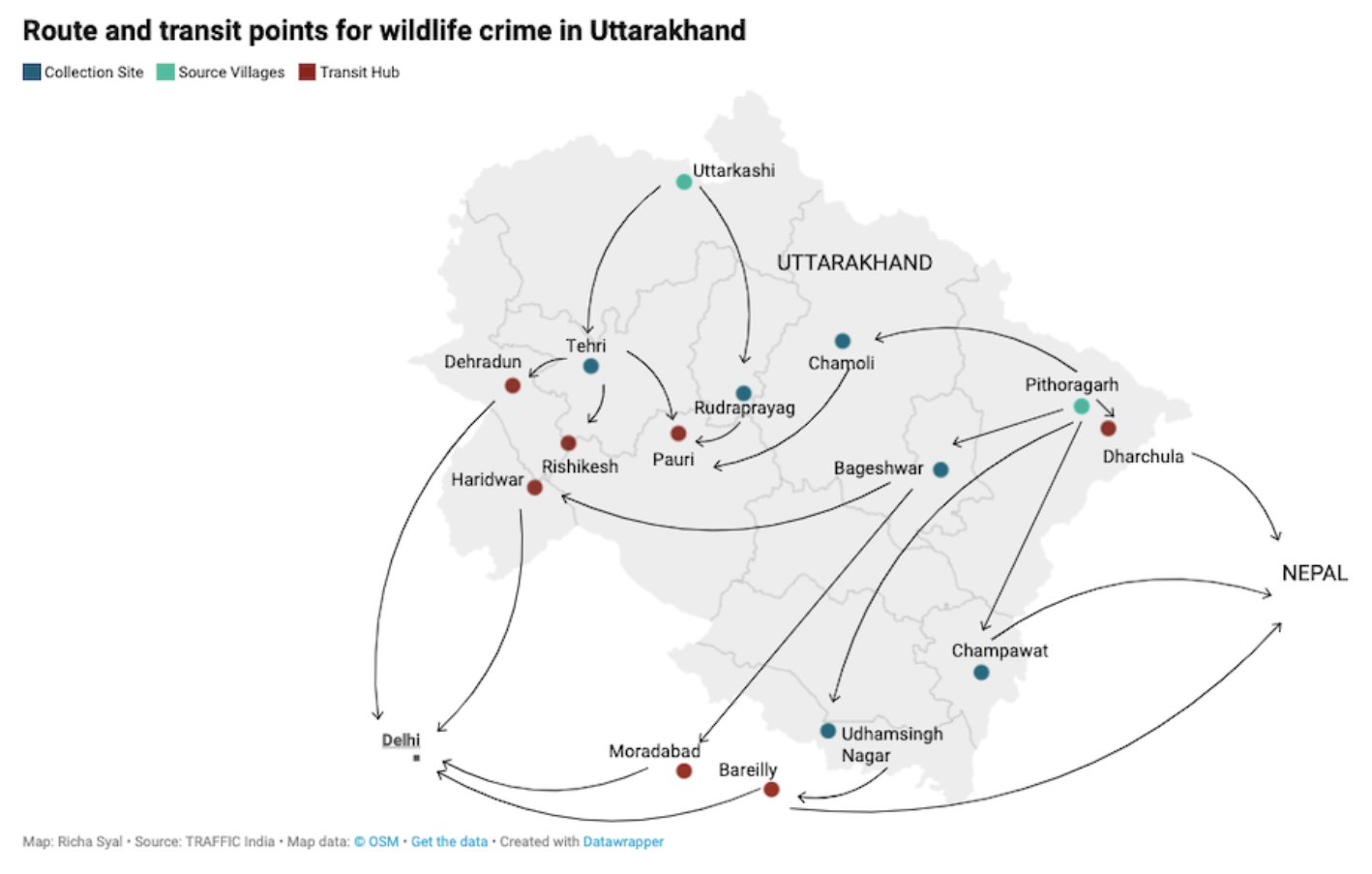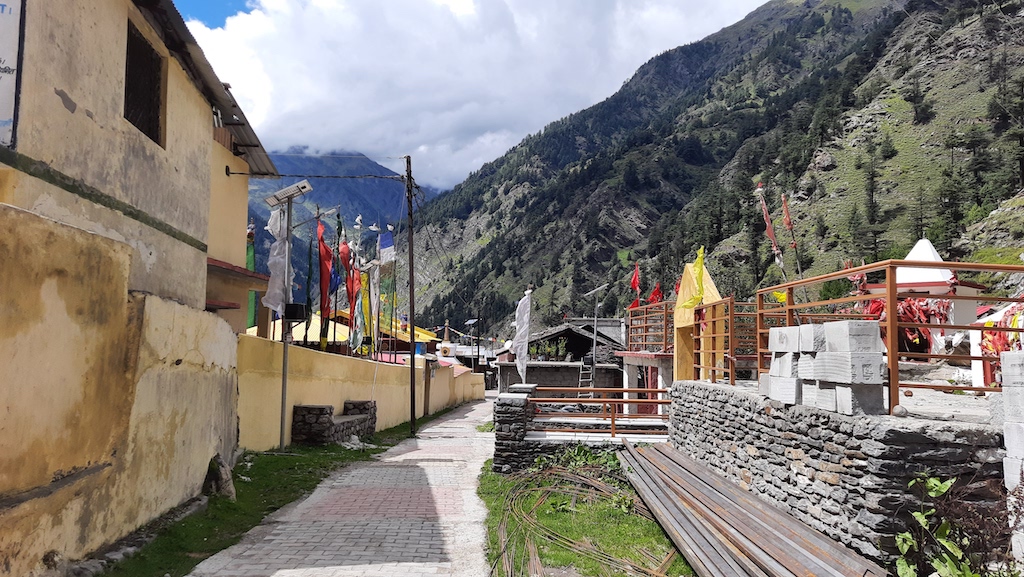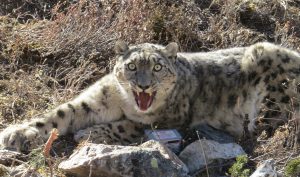Snow leopards, the “mountain ghosts” of the Himalayas, live in inaccessible, icy and largely unpopulated mountain ranges about 3,000 metres above sea level. To conserve this threatened big cat, there are many projects brought together by the Global Snow Leopard and Ecosystem Protection Programme. Despite this, snow leopard poaching and trafficking data has not been compiled in one place – even though snow leopards are listed under Schedule 1 of the Wildlife Protection Act in India and as vulnerable by the International Union for the Conservation of Nature (IUCN), meaning that the species is threatened with extinction unless the circumstances that are threatening its survival and reproduction improve.
High security
Snow leopard habitat is intersected by many international frontiers. In the state of Uttarakhand in northern India, its habitat is shared by the Indian Army, Border Security Force (SSB) and Indo-Tibetan Border Police in this high-security region.
Despite this, information collated from Traffic India, the Wildlife Protection Society of India, the police in Uttarakhand’s capital Dehradun and local media reports indicates that at least 10 snow leopard skins were recovered in this one state between 2000 and 2012, and at least 10 criminal charges were made. The Uttarakhand Forest Department however said in response to a request under the Right to Information Act that only one skin had been seized during this period. The SSB reported one snow leopard skin seized in the city of Pithoragarh in March 2012, and in December 2012 the Special Task Force of the police reported seizing a skin in Dehradun. The data is scattered due to the multiplicity of agencies.
10
Number of snow leopard skins recovered by authorities in Uttarakhand over 12 years
According to S Sathyakumar, a scientist at the Wildlife Institute of India in Dehradun, there are an estimated 85 snow leopards in Uttarakhand and between 450 and 500 in India. A census is currently being carried out and is expected to be completed by March 2022, he said. In Uttarakhand, snow leopards have been seen in Gangotri National Park, Nelang Valley, Nanda Devi Biosphere Reserve and in Pithoragarh district along the border with Nepal.
Trafficking routes for snow leopard poaching
The Uttarakhand Forest Department, in association with Traffic India, has identified hotspots, source villages and local-national-international transit routes for wildlife crime in the state. The authorities have found that the state is vulnerable to poaching and trafficking of wildlife, including tigers, snow leopards, elephants and musk deer.
Villages adjoining the Gangotri National Park in the Uttarkashi district have been identified as sources of wildlife contraband, and so have villages situated around the Lipulekh mountain pass near the trading town of Taklakot in Tibet. Both areas are close to snow leopard habitat and the cats are often seen here at altitudes below 2,600 metres in winter.
The Traffic report identifies collection sites of wildlife contraband in the districts of Champawat, Udhamsinghnagar, Bageshwar adjoining Pithoragarh, Chamoli, Rudraprayag, Pauri and Tehri adjoining Uttarkashi. From these collection sites local transit points include Dehradun, Haridwar, Bareilly and Moradabad, which are in the adjoining state of Uttar Pradesh. The national transit point Delhi is located about 200 km from these local transit points.

Champawat, Dharchula in Pithoragarh, Udhamsinghnagar and Bareilly all share a border with Nepal. This entire area has been identified by the authorities as a hub of international wildlife trafficking routes, including snow leopard poaching and trafficking.
Uttarakhand shares a border of about 275 km with Nepal. There are eight official transit points. The Kali River – called Mahakali in Nepal – forms the border for much of this distance. It is unguarded.
If hunters of common leopards come to know about the presence of a snow leopard or get information about a dead snow leopard, then they try to kill or sell itSaket Badola, head of Traffic India
Chandan Singh, station officer at Pithoragarh police station, said people cross the Kali River by swimming and using tyre tubes. He said it is not possible to guard such a long, open border. According to Saket Badola, head of Traffic India, “Targeted snow leopard poaching does not take place as the animal is not easily accessible, but opportunistic killing or trading can be done. If hunters of common leopards come to know about the presence of a snow leopard or get information about a dead snow leopard, then they try to kill or sell it.”
In the villages, no admission of snow leopard poaching
Bagori village in Uttarkashi district is mainly a village of cattle herders of the Bhotia indigenous community. The sheep herders go with their livestock to the Nelang Valley along the Chinese border during the summer. The villagers of Bagori also contributed to establishing the Indo-Tibetan market in Nelang before it was closed due to the 1962 China-India war.
Rajendra Singh Negi, a herder from this village, has been taking his flocks to the Nelang-Jadung area near the Chinese border since 1972. After staying around Nelang from June to August, he returns to Bagori in September every year with about 400 sheep and goats.
“A snow leopard has attacked some animals of the village some time back,” Negi said. “We get to know its presence by the way it hunts. It kills many animals at once. Snow leopards are very difficult to see.”
He denied hunting snow leopards. “No one can go there to hunt it. There are army checkpoints everywhere. The Nelang-Jadung area cannot be visited without permission.”

Mohan Singh, a farmer from Sukhi village near the town of Harshil, said: “We feel the presence of snow leopards in the meadows above the village during winters.” But he was reluctant to comment on hunting. “If the dependence of the people on the forest is to be reduced, then an arrangement about their employment has to be made,” he said.
Camera trap problems
Madhavendra Singh Rawat, head of the forest panchayat (council) of Harshil, adjacent to Bagori, said when an attempt was made to install camera traps in some villages close to the Gangotri National Park to monitor wildlife, the villagers resisted. If the villagers see the cameras, they uproot them and throw them away.
“There are two difficulties in installing camera traps in villages in the high Himalayan region,” according to Tito Joseph, programme manager at the Wildlife Protection Society of India. “The first is related to conflict and the second is to hunting.”
“We have seen cases of snow leopards being poisoned by villagers when they attack their animals. In the case of hunting, hunters from outside contact the local people. No outsider can hunt here without the help of a local person,” Rawat said.
“We have found that outside hunters tell the local villagers that if they can catch this animal or find its carcass, then they give them its skin and nails and in return they will get money. It is possible that due to these reasons most of the villagers do not want to allow camera traps to be installed. Nor do they want to talk about hunting. It is very important to develop local intelligence to gather information on this.” Joseph also said that demand for skins, bones, claws and other parts of tigers, snow leopards and other wild cats comes from outside the country. “There is an international trade and market for illegal wildlife. So, we cannot say that the snow leopard or other wildlife animals are not being hunted. But we do not have the data for this.” Saket Badola, from Traffic India, reiterated the same point.
Lack of convictions
1
Number of convictions secured from court cases involving snow leopard poaching in Uttarakhand since 2000
The biggest problem with wildlife crime is that the conviction rate is low, Joseph said. Under the Wildlife Conservation Act, there is provision for imprisonment of three to seven years in jail, and/or a fine of up to INR 10,000 (about USD 134), for wildlife crimes. Out of the court cases involving snow leopard poaching registered in Uttarakhand since 2000, only one conviction was secured in 2012 – and the convicted were later acquitted on appeal.
The case involved two people arrested by the SSB with a snow leopard skin from Dharchula area of Pithoragarh on 24 March 2012. A local judge sentenced them to three years’ imprisonment each and a fine of INR 10,000. However, they appealed to a higher court and were acquitted. There have been more recent arrests. Nand Ballabh Sharma, officer in charge of the Nanda Devi Biosphere Reserve, said: “In 2020, 19 hunters with around 300 traps were caught in Chamoli between September and November. One of them has got bail; the rest are in jail awaiting trial.”
Lack of central database on snow leopard poaching
“We don’t have enough and substantial information,” said Aishwarya Maheshwari, who has worked with Traffic India as a researcher and is currently working at Banda University of Agriculture and Technology in Uttar Pradesh. “The most important gap is that there is no central database as far as snow leopard illegal trade is concerned.”
“All the snow leopard host regions in Central and Southern Asia are united for protection of the snow leopard under CITES,” Maheshwari added. CITES, the Convention on International Trade in Endangered Species, is a global treaty for regulating international trade in endangered and vulnerable species, and now has more than 180 signatories.
“In terms of conference 12.5 [in 2002], all the parties are mandated to report any kind of illegal snow leopard trade incident in their country to CITES so that a central database can be maintained,” Maheshwari said. “It would be helpful not just to look at what is currently happening but at how the trend is going.”
This report is part of a series on illegal trade in snow leopards, supported by Oxpeckers Investigative Environmental Journalism and the Global Initiative Against Transnational Organized Crime

![A snow leopard in Uttarakhand [image by: Sonu Negi]](https://dialogue.earth/content/uploads/2020/10/Featured_image_PIC_credit_Sonu_Negi_1-300x200.jpg)


![Photograph of Alcu the elusive leopard at the snow leopard rehabilitation centre, Issyk-Kul [image by: Juhi Chaudhary]](https://dialogue.earth/content/uploads/2017/09/Snow-leopard1-300x225.jpg)



